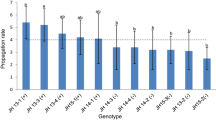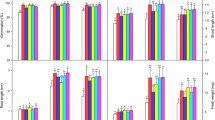Abstract
The green marine macroalga, Ulva linza, adopts an “atypical” form when grown in the absence of bacteria. Twenty unique strains of periphytic bacteria, isolated from three species of Ulva, were identified by 16S rDNA sequencing. These isolates were assessed for their effect on the growth and morphological development of axenic plantlets of U. linza. Results showed that the effect of bacterial strains was strain- but not taxon-specific. Thirteen isolates returned the aberrant morphology to normal and of these, five also significantly increased growth rate. One isolate increased growth, but had no effect on morphology. Biofilms of some of these isolates stimulated the settlement of Ulva zoospores but there was no correlation between bacterial isolates that stimulated zoospore settlement and those that initiated changes in morphology and/or growth of the cultured alga.



Similar content being viewed by others
References
Agaki, Y, Taga, N, Simidu, U (1977) Isolation and distribution of oligotrophic marine bacteria. Can J Microbiol 23: 981–987
Armstrong, E, Rogerson, A, Leftley, JW (2000) The abundance of heterotrophic protists associated with intertidal seaweeds. Estuar Coast Shelf Sci 50: 415–424
Armstrong, E, Rogerson, A, Leftley, JW (2000) Utilisation of seaweed carbon by three surface-associated heterotrophic protists, Steromyxa ramosa, Nitzschia alba and Labyrinthula sp. Aquat Microb Ecol 21: 49–57
Armstrong, E, Tyan, L, Boyd, KG, Wright, PC, Burgess, JG (2001) The symbiotic role of marine microbes on living surfaces. Hydrobiology 461: 37–40
Ashen, JB, Goff, LJ (2000) Molecular and ecological evidence for species specificity and coevolution in a group of marine algal–bacterial symbioses. Appl Environ Microbiol 66: 3024–3030
Callow, ME, Callow, JA, Pickett-Heaps, JD, Wetherbee, R (1997) Primary adhesion of Enteromorpha (Chlorophyta, Ulvales) propagules: quantitative settlement studies and video microscopy. J Phycol 33: 938–947
Chisholm, JRM, Dauga, C, Ageron, E, Grimont, PAD, Jaubert, JM (1996) Roots in mixotrophic algae. Nature 381: 565
Dobretsov, SV, Qian, PY (2002) Effect of bacteria associated with the green alga Ulva reticulata on marine micro- and macrofouling. Biofouling 18: 217–228
Fries, L (1975) Some observations on the morphology of Enteromorpha linza (L.) J. Ag. and Enteromorpha compressa (L.) Grev. in axenic culture. Bot Mar 18: 251–253
Gish, W (1996–2003) http://blast.wustl.edu
Holmström, C, James, S, Egan, S, Kjelleberg, S (1996) Inhibition of common fouling organisms by marine bacterial isolates with special reference to the role of pigmented bacteria. Biofouling 10: 251–259
Joint, I, Callow, ME, Callow, JA, Clarke, KR (2000) The attachment of Enteromorpha zoospores to a bacterial biofilm assemblage. Biofouling 16: 151–158
Joint, I, Tait, K, Callow, ME, Callow, JA, Milton, D, Williams, P, Cámara, M (2002) Cell-to-cell communication across the procaryote–eucaryote boundary. Science 298: 1207
Lüning, K (1990) Seaweeds: Their Environment, Biogeography and Ecophysiology. Wiley-Interscience, New York
LaPara, TM, Nakatsu, CH, Pantea, L, Alleman, JE (2000) Phylogenetic analysis of bacterial communities in mesophilic and thermophilic bioreactors treating pharmaceutical wastewater. Appl Environ Microbiol 66: 3951–3959
Matsuo, Y, Suzuki, M, Kasai, H, Shizuri, Y, Harayama, S (2003) Isolation and phylogenetic characterization of bacteria capable of inducing differentiation in the green alga Monostroma oxyspermum. Environ Microbiol 5: 25–35
Matsuo, Y, Imagawa, H, Nishizawa, M, Shizuri, Y (2005) Isolation of an algal morphogenesis inducer from a marine bacterium. Science 307: 1598
Maximilien, R, de Nys, R, Holmström, C, Gram, L, Givskov, M, Crass, K, Kjelleberg, S, Steinberg, PD (1998) Chemical mediation of bacterial surface colonisation by secondary metabolites from the red alga Delisea pulchra. Aquat Microb Ecol 15: 233–246
Muyzer, G, Dewaal, EC, Uitterlinden, AG (1993) Profiling of complex microbial populations by denaturing gradient gel electrophoresis analysis of polymerase chain reaction amplified genes coding for 16S ribosomal-RNA. Appl Environ Microbiol 59: 695–700
Nakanishi, K, Nishijima, M, Nishimura, M, Kuwano, K, Saga, N (1996) Bacteria that induce morphogenesis in Ulva pertusa (chlorophyta) grown under axenic conditions. J Phycol 32: 479–482
Nakanishi, K, Nishijima, M, Nomoto, AM, Yamazaki, A, Saga, N (1999) Requisite morphologic interaction for attachment between Ulva pertusa (Chlorophyta) and symbiotic bacteria. Mar Biotech 1: 107–111
Nakatsu, CH, Torsvik, V, Ovreas, L (2000) Soil community analysis using DGGE of 16S rDNA polymerase chain reaction products. J Soil Sci Soc Am 64: 1382–1388
Nelson, LS (1998) The Anderson–Darling test for normality. J Qual Technol 30: 298–299
O'Sullivan, LA, Weightman, AJ, Fry, JC (2002) New degenerate Cytophaga–Flexibacter–Bacteroides specific 16S ribosomal DNA-targeted oligonucleotide probes reveal high bacterial diversity in River Taff epilithon. Appl Environ Microbiol 68: 201–210
Patel, P, Callow, ME, Joint, I, Callow, JA (2003) Specificity in the settlement-modifying response of bacterial biofilms towards zoospores of the marine alga Enteromorpha. Environ Microbiol 5: 338–349
Provasoli, L, Pintner, IJ (1980) Bacteria induced polymorphism in axenic laboratory strain of Ulva lactuca (Chlorophyceae). J Phycol 16: 196–201
Quinn, GP, Keough, MJ (2002) Experimental Design and Data Analysis for Biologists. Cambridge University Press, Cambridge
Saga, N, Sakai, Y (1982) A new method for pure culture of macroscopic algae, the one step selection method. Jpn J Phycol 30: 40–43
Sakami, T, Nakahara, H, Chinain, M, Ishida, Y (1999) Effects of epiphytic bacteria on the growth of the toxic dinoflagellate Gambierdiscus toxicus (Dinophyceae). J Exp Mar Biol Ecol 233: 231–246
Shiba, T, Taga, N (1980) Heterotrophic bacteria attached to seaweeds. J Exp Mar Biol Ecol 47: 251–258
Stratmann, J, Paputsoglu, G, Oertel, W (1996) Differentiation of Ulva mutabilis (Chlorophyta) gametangia and gamete release are controlled by extracellular inhibitors. J Phycol 32: 1009–1021
Suzuki, MT, Rappé, MS, Haimberger, ZW, Winfield, H, Adair, N, Strobel, J, Giovannoni, SJ (1997) Bacterial diversity among small-subunit rRNA gene clones and cellular isolates from the same seawater sample. Appl Environ Microbiol 63: 983–989
Tait, K, Joint, I, Daykin, M, Milton, DL, Williams, P, Cámara, M (2005) Disruption of quorum sensing in seawater abolishes attraction of zoospores of the green alga Ulva to bacterial biofilms. Environ Microbiol 7: 229–240
Tatewaki, M, Provasoli, L, Pintner, IJ (1983) Morphogenesis of Monostroma oxyspermum (Kutz) Doty (Chlorophyceae) in axenic culture, especially in bioalgal culture. J Phycol 19: 409–416
Thompson, JD, Higgins, DG, Gibson, TJ (1994) Clustal-W—improving the sensitivity of progressive multiple sequence alignment through sequence weighting, position-specific gap penalties and weight matrix choice. Nucleic Acids Res 22: 4673–4680
Acknowledgments
This research was support by the Natural Environment Research Council through grant number NER/T/S/2000/00623. We thank Karen Tait for helpful advice on bacterial cell signaling.
Author information
Authors and Affiliations
Corresponding author
Rights and permissions
About this article
Cite this article
Marshall, K., Joint, I., Callow, M.E. et al. Effect of Marine Bacterial Isolates on the Growth and Morphology of Axenic Plantlets of the Green Alga Ulva linza . Microb Ecol 52, 302–310 (2006). https://doi.org/10.1007/s00248-006-9060-x
Received:
Accepted:
Published:
Issue Date:
DOI: https://doi.org/10.1007/s00248-006-9060-x




